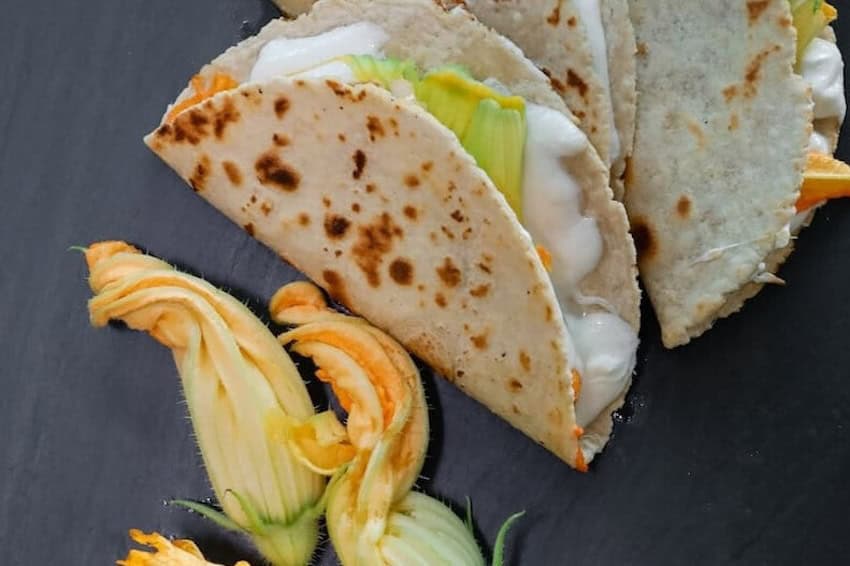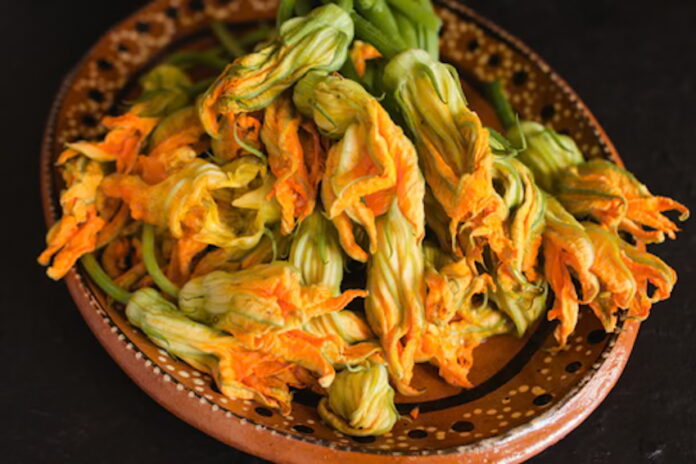The squash plant, or “flor de calabaza” as it is ubiquitously known in Mexico, was a fundamental part of the milpa system for pre-Columbian cultures. But perhaps even more important than the plant itself was the role of its flowers.
In the Mesoamerican cosmovision, flowers were everything. They were medicine, food, decoration, pigment, offering, symbol, omen and poetry.

In societies ruled by agriculture, like theirs, flowers marked the beginning of the agricultural cycle. Because of that, they represented abundance and renewal. Like us, pre-Columbian peoples saw flowers as something delicate, so fragile that they also symbolized the profound respect they held for the balance required by nature — and, by extension, for the gods who manifested through nature itself.
The diverse foundational myths across Indigenous cultures reveal the profound reverence forsacred plants and flowers. Another indication of their importance is the depiction of flowers in murals, pottery, and other archaeological pieces. In Teotihuacan, for instance —the “City of the Gods” — the depiction of flowers was associated with music, poetry, and the beauty of language.
Imagine eating something that carries all those meanings.
Squash blossom
According to archaeological records, the squash was the first plant cultivated by Mesoamericans around 10,000 years ago. And not a single part of it went to waste: the seeds, the flesh, the stem, and of course, the flower were used in some way.
The blossom, known in Nahuatl as ayoxóchquilitl — according to the chronicler Fray Bernardino de Sahagún — commonly eaten, usually cooked, or added to stews.
View this post on Instagram
Harvesting the blossoms was — and still is — a delicate event. You have to pick them early in the morning, before the sun wilts them. They bloom only for a single day, so timing is everything. And you must handle them with care, remembering that ancient respect for the gifts of the earth.
Flor de calabaza today
This humble field food has made a spectacular leap into Mexico’s most high-end kitchens. And it’s no wonder — its flavor is extraordinary: slightly sweet, slightly herbaceous. Its delicate taste makes it a star ingredient in quesadillas, soups, creamy stews, tamales, fritters and any dish you can think of.
My favorite way to eat squash blossoms? In a quesadilla with epazote. But equally satisfying is squash blossom soup with young corn and diced zucchini, commonly known as sopa de milpa. Not only is it delicious — it’s also incredibly nutritious.
Super flower
If you’re looking for the perfect nutritional sidekick to your meal, squash blossoms are it. A small bunch is packed with vitamins A, B1, B2, B3, B9, and C. They also contain significant amounts of calcium, iron, phosphorus, potassium and magnesium, plus flavonoids and antioxidants.

So what does this mean for your health? Squash blossoms can help prevent osteoporosis, promote healthy growth in children, and support strong eyesight. They’re also great for urinary health, boost cardiovascular function, lower cholesterol, support pregnancy, and even help fight the common cold.
In short, squash blossoms are a bona fide superfood.
So, my friends, I know you’re going to want to try this delight for yourselves. Here’s my recipe for Sopa de Milpa — a bowl that’s as comforting as it is meaningful.
Milpa Soup Recipe (Serves 4–6)
Ingredients
Instructions
Notes:
Amigos, I like to think that eating this squash blossom soup isn’t just about honoring Mexican culinary traditions — it’s also a beautiful act of reconnecting with the ancient reverence for nature and its delicate balance.
And, don’t you think there’s something wildly luxurious about eating the colorful and delicious flor de calabaza?
María Meléndez is a Mexico City food blogger and influencer.
